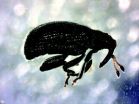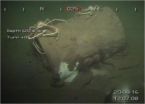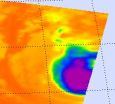(Press-News.org) NARRAGANSETT, R.I. – September 28, 2012 – Scientists at the University of Rhode Island's Graduate School of Oceanography have made the first observation of a predator avoidance behavior by a species of phytoplankton, a microscopic marine plant. Susanne Menden-Deuer, associate professor of oceanography, and doctoral student Elizabeth Harvey made the unexpected observation while studying the interactions between phytoplankton and zooplankton.
Their discovery will be published in the September 28 issue of the journal PLOS ONE.
"It has been well observed that phytoplankton can control their movements in the water and move toward light and nutrients," Menden-Deuer said. "What hasn't been known is that they respond to predators by swimming away from them. We don't know of any other plants that do this."
While imaging 3-dimensional predator-prey interactions, the researchers noted that the phytoplankton Heterosigma akashiwo swam differently in the presence of predators, and groups of them shifted their distribution away from the predators.
In a series of laboratory experiments, Menden-Deuer and Harvey found that the phytoplankton not only flee when in the presence of the predatory zooplankton, but they also flee when in water that had previously contained the predators. They found only a minimal effect when the phytoplankton were exposed to predators that do not feed on phytoplankton.
"The phytoplankton can clearly sense the predator is there. They flee even from the chemical scent of the predator but are most agitated when sensing a feeding predator," said Menden-Deuer.
When the scientists provided the phytoplankton with a refuge to avoid the predator – an area of low salinity water that the predators cannot tolerate – the phytoplankton moved to the refuge.
The important question these observations raise, according to Menden-Deuer, is how these interactions affect the survival of the prey species.
Measuring survival in the same experiments, the researchers found that fleeing helps the alga survive. Given a chance, the predators will eat all of the phytoplankton in one day if the algae have no safe place in which to escape, but they double every 48 hours if they have a refuge available to flee from predators. Fleeing makes the difference between life and death for this species, said Menden-Deuer.
"One of the puzzling things about some phytoplankton blooms is that they suddenly appear," she said. "Growth and nutrient availability don't always explain the formation of blooms. Our observation of algal fleeing from predators is another mechanism for how blooms could form. Amazingly, looking at individual microscopic behaviors can help to explain a macroscopic phenomenon."
The researchers say there is no way of knowing how common this behavior is or how many other species of phytoplankton also flee from predators, since this is the first observation of such a behavior.
"If it is common among phytoplankton, then it would be a very important process," Menden-Deuer said. "I wouldn't be surprised if other species had that capacity. It would be very beneficial to them."
In future studies, she hopes to observe these behaviors in the ocean and couple it with genetic investigations.
### Funding for this research was provided by the National Science Foundation, the National Oceanic and Atmospheric Administration, and the U.S. Department of Agriculture. The study was conducted, in part, at the URI Marine Life Science Facility, which is supported by the Rhode Island Experimental Program to Stimulate Competitive Research.
URI scientists: Marine plants can flee to avoid predators
First observation of predator avoidance behavior by phytoplankton
2012-09-29
ELSE PRESS RELEASES FROM THIS DATE:
An old insect pest reemerges in organic orchards
2012-09-29
The apple flea weevil, a sporadic insect pest in the early 1900s, has reemerged as a severe pest in organic apple orchards in Michigan, where outbreak population levels have been observed since 2008, and damage has resulted in up to 90% losses for apple growers.
According to the authors of "The Reemergence of an Old Pest, Orchestes pallicornis (Coleoptera: Curculionidae)," an open-access article appearing in the lastest issue of the Journal of Integrated Pest Management, the weevil can be managed by broad-spectrum insecticides used in conventional agriculture, but there ...
Researchers find multiple similarities between cancer cells and induced pluripotent stem cells
2012-09-29
(SACRAMENTO, Calif.) — UC Davis investigators have found new evidence that a promising type of stem cell now being considered for a variety of disease therapies is very similar to the type of cells that give rise to cancer. The findings suggest that although the cells -- known as induced pluripotent stem cells (iPSCs) -- show substantial promise as a source of replacement cells and tissues to treat injuries, disease and chronic conditions, scientists and physicians must move cautiously with any clinical use because iPSCs could also cause malignant cancer.
The article, ...
New method monitors semiconductor etching as it happens -- with light
2012-09-29
CHAMPAIGN, Ill. — University of Illinois researchers have a new low-cost method to carve delicate features onto semiconductor wafers using light – and watch as it happens.
"You can use light to image the topography and you can use light to sculpture the topography," said electrical and computer engineering professor Gabriel Popescu. "It could change the future of semiconductor etching."
Chip makers and semiconductor researchers need to very precisely control the dimensions of their devices. The dimensions of the components affect performance, speed, error rate and time ...
Tadpole shrimp a new pest of rice in the midsouthern United States
2012-09-29
Tadpole shrimp are pests of rice production systems in California and have recently been found impacting Missouri and Arkansas rice fields. The shrimp feed on rice seedlings and uproot them during foraging, and their foraging behavior causes water to become muddy, which reduces light penetration to submerged seedlings and delays the development of the rice plant.
In "Review of a New Pest of Rice, Tadpole Shrimp (Notostraca: Triopsidae), in the Midsouthern United States and a Winter Scouting Method of Rice Fields for Preplanting Detection," a new open-access article appearing ...
Bored? Researchers shed light on why
2012-09-29
This gives new meaning to the complaint "I'm bored" — literally.
Canadian researchers — including a professor from the University of Guelph — have come up with a new, precise definition of boredom based on the mental processes that underlie the condition.
Although many people may see boredom as trivial and temporary, it actually is linked to a range of psychological, social and health problems, says Guelph psychology professor Mark Fenske. He's among authors of a new study in Perspectives on Psychological Science, published by the Association for Psychological Science.
Boredom ...
Time bomb: Military ordnance in Gulf poses threat to shipping, says Texas A&M proffesor
2012-09-29
Millions of pounds of unexploded bombs and other military ordnance that were dumped decades ago in the Gulf of Mexico, as well as off the coasts of both the Atlantic and Pacific oceans, could now pose serious threats to shipping lanes and the 4,000 oil and gas rigs in the Gulf, warns two Texas A&M University oceanographers.
William Bryant and Neil Slowey, professors of oceanography who have more than 90 years of combined research experience in all of the Earth's oceans, along with fellow researcher Mike Kemp of Washington, D.C., say millions of pounds of bombs are scattered ...
IUCN adopts new 'Green List' to show species on the path to conservation success
2012-09-29
The IUCN World Conservation Congress has adopted a motion sponsored by the Wildlife Conservation Society and partners to create a Green List to assess conservation success. The Green List for Species would include species identified as 'fully conserved,' which are those that exist in ecologically significant numbers, interacting fully with other species in their ecosystems.
The motion was adopted at the World Conservation Congress, which was held this month in Jeju, Republic of Korea.
The aim of the Green List is to highlight species that are thriving parts of a healthy ...
NASA sees super Typhoon Jelawat Affecting Japan
2012-09-29
Super Typhoon Jelawat is a large and powerful storm that has been bringing very rough seas to areas in the western North Pacific. NASA's Terra satellite passed over the monster storm and captured a visible image as it nears the big island of Japan.
NASA's Terra satellite passed over Super Typhoon Jelawat on Sept. 28 at 0238UTC (10:38 p.m. EDT, Sept. 27) and the Moderate Resolution Imaging Spectroradiometer captured an infrared image as the storm approaches Okinawa, Japan.
Jelawat's center passed by Ishigaki-jima by 1500 UTC (11 a.m. EDT) on Sept. 28 and was approaching ...
NASA sees sun unleash a wide, but benign, CME
2012-09-29
The sun erupted with a wide, Earth-directed coronal mass ejection (CME) on Sept. 27, 2012 at 10:25 p.m. EDT. CMEs are a phenomenon that can send billions of tons of solar particles into space that can reach Earth one to three days later, affecting electronic systems in satellites and on the ground. Experimental NASA research models estimate that the CME is traveling at around 700 miles per second and will reach Earth on Sept. 29.
CMEs of these speeds are usually benign. In the past, similar CMEs have caused auroras near the poles but have not caused disruption to electrical ...
NASA sees stubborn Nadine intensify into a hurricane again
2012-09-29
Infrared data from NASA's Aqua satellite today, Sept. 28, revealed strong convection and thunderstorms have built up again in Tropical Storm Nadine as it moved over warm waters in the Eastern Atlantic Ocean. That convection strengthened Nadine back into a hurricane today. Nadine has lasted over two weeks, but is nowhere near breaking the record for longest-lived tropical cyclone.
NASA's Aqua satellite passed over long-lived Nadine on Sept. 28 at 0441 UTC (12:41 a.m. EDT) when it was still a tropical storm and the Atmospheric Infrared Sounder (AIRS) instrument captured ...
LAST 30 PRESS RELEASES:
Making lighter work of calculating fluid and heat flow
Normalizing blood sugar can halve heart attack risk
Lowering blood sugar cuts heart attack risk in people with prediabetes
Study links genetic variants to risk of blinding eye disease in premature infants
Non-opioid ‘pain sponge’ therapy halts cartilage degeneration and relieves chronic pain
AI can pick up cultural values by mimicking how kids learn
China’s ecological redlines offer fast track to 30 x 30 global conservation goal
Invisible indoor threats: emerging household contaminants and their growing risks to human health
Adding antibody treatment to chemo boosts outcomes for children with rare cancer
Germline pathogenic variants among women without a history of breast cancer
Tanning beds triple melanoma risk, potentially causing broad DNA damage
Unique bond identified as key to viral infection speed
Indoor tanning makes youthful skin much older on a genetic level
Mouse model sheds new light on the causes and potential solutions to human GI problems linked to muscular dystrophy
The Journal of Nuclear Medicine ahead-of-print tip sheet: December 12, 2025
Smarter tools for peering into the microscopic world
Applications open for funding to conduct research in the Kinsey Institute archives
Global measure underestimates the severity of food insecurity
Child survivors of critical illness are missing out on timely follow up care
Risk-based vs annual breast cancer screening / the WISDOM randomized clinical trial
University of Toronto launches Electric Vehicle Innovation Ontario to accelerate advanced EV technologies and build Canada’s innovation advantage
Early relapse predicts poor outcomes in aggressive blood cancer
American College of Lifestyle Medicine applauds two CMS models aligned with lifestyle medicine practice and reimbursement
Clinical trial finds cannabis use not a barrier to quitting nicotine vaping
Supplemental nutrition assistance program policies and food insecurity
Switching immune cells to “night mode” could limit damage after a heart attack, study suggests
URI-based Global RIghts Project report spotlights continued troubling trends in worldwide inhumane treatment
Neutrophils are less aggressive at night, explaining why nighttime heart attacks cause less damage than daytime events
Menopausal hormone therapy may not pose breast cancer risk for women with BRCA mutations
Mobile health tool may improve quality of life for adolescent and young adult breast cancer survivors
[Press-News.org] URI scientists: Marine plants can flee to avoid predatorsFirst observation of predator avoidance behavior by phytoplankton





